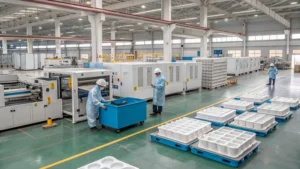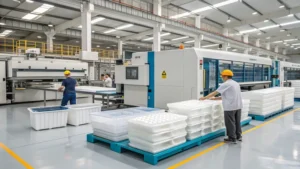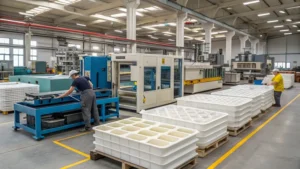
Vacuum forming and vacuum casting are two distinct manufacturing processes that utilize vacuum pressure to create plastic parts, each offering unique advantages depending on your project needs. While they share some similarities, their methods, materials, and applications differ significantly, making it essential to understand their nuances to choose the right technique.
Vacuum forming1 shapes heated plastic sheets over a mold using vacuum pressure, while vacuum casting pours liquid resin into a silicone mold under vacuum to produce detailed parts.
Both processes are widely used in industries like packaging, automotive, and prototyping, but they cater to different requirements. Vacuum forming excels at producing large, simple components quickly, whereas vacuum casting2 is ideal for small, intricate parts with high detail. This blog post will break down each process, compare their differences, and guide you through choosing the best option for your project.
Vacuum forming and vacuum casting are essentially the same process.False
While both use vacuum pressure, vacuum forming shapes plastic sheets, whereas vacuum casting involves pouring liquid resin into a mold.
Vacuum casting is better for high-volume production than vacuum forming.False
Vacuum forming is more cost-effective for larger runs, while vacuum casting suits small batches due to mold lifespan limits.
What is Vacuum Forming?
Vacuum forming, sometimes called thermoforming, is a straightforward process where a thermoplastic sheet3 is heated until pliable, then draped over a mold and shaped using vacuum pressure. Once cooled, the plastic hardens into the mold’s form, ready for trimming and finishing. It’s a go-to method for creating large, shallow parts like trays, dashboards, or signage.

Vacuum forming heats and shapes plastic sheets over a mold using vacuum pressure, perfect for large, simple parts in packaging, automotive, and signage industries.
| Aspect | Details |
|---|---|
| Materials | Thermoplastics like ABS, PVC, PETG, and HIPS |
| Mold Types | Wood, aluminum, or 3D-printed molds |
| Typical Thickness | 0.5 mm to 6 mm |
| Production Volume | Low to medium (hundreds to thousands of parts) |
How Does Vacuum Forming Work?
Here’s how it happens step-by-step:

-
Heating the Sheet: A thermoplastic sheet is clamped in a frame and heated until it’s soft and stretchy.
-
Shaping with Vacuum: The pliable sheet is lowered over a mold, and a vacuum sucks it tightly against the mold’s contours.
-
Cooling and Finishing: The plastic cools, solidifying into shape. Excess material is trimmed off, often with CNC tools, to complete the part.
This process is fast, affordable, and great for big parts with basic shapes. Think of it like shaping dough over a pan—it’s simple but effective.
Vacuum forming can produce highly detailed parts.False
It’s best for simpler shapes; intricate details are limited by the sheet-forming method.
Vacuum forming is suitable for prototyping.True
Its low tooling costs and quick setup make it ideal for prototyping large components.
What is Vacuum Casting?
Vacuum casting, also known as urethane casting, is a more detailed process that starts with a master pattern—often made via 3D printing or CNC machining. A silicone mold is created around this pattern, and liquid polyurethane resin is poured in under vacuum to eliminate air bubbles, producing precise, high-quality parts.

Vacuum casting uses silicone molds and liquid resin to craft detailed, small-batch parts for prototyping, medical devices, and consumer products.
| Aspect | Details |
|---|---|
| Materials | Polyurethane resins mimicking ABS, rubber, etc. |
| Mold Lifespan | 20-50 parts per mold |
| Typical Thickness | Varies; excels with thin walls |
| Production Volume | Low (tens to hundreds of parts) |
How Does Vacuum Casting Work?
Here’s the breakdown:

-
Master Pattern Creation: A precise model is made, typically with 3D printing or CNC machining.
-
Silicone Mold Making4: The pattern is encased in silicone, which cures into a flexible mold.
-
Resin Pouring: Liquid resin is mixed, deaerated, and poured into the mold under vacuum to ensure a smooth finish.

- Curing and Removal: The resin hardens in the mold, and the part is removed and finished as needed.
It’s like pouring cake batter into a mold—except with resin and a vacuum, you get detailed parts perfect for prototypes or small runs.
Vacuum casting can produce parts with complex geometries.True
Flexible silicone molds allow for intricate designs and undercuts.
Vacuum casting is cost-effective for large production runs.False
Silicone molds wear out after 20-50 parts, making it less economical for high volumes.
What are the Key Differences Between Vacuum Forming and Vacuum Casting?
While both rely on vacuum pressure, their approaches and outcomes couldn’t be more different. Let’s compare them across key factors.

Vacuum forming suits large, simple parts with thermoplastic sheets, while vacuum casting excels at small, detailed parts with liquid resin in silicone molds.
Comparison Table
| Feature | Vacuum Forming | Vacuum Casting |
|---|---|---|
| Materials | Thermoplastic sheets (ABS, PVC) | Polyurethane resins |
| Mold Type | Rigid (wood, aluminum) | Flexible (silicone) |
| Part Complexity | Simple shapes, minimal undercuts | Complex shapes, fine details |
| Production Volume | Medium (hundreds to thousands) | Low (tens to hundreds) |
| Cycle Time | Fast (minutes per part) | Slower (hours including curing) |
| Applications | Packaging, automotive interiors | Prototypes, medical devices |
Key Insights
- Process: Vacuum forming stretches a heated sheet, while vacuum casting fills a mold with liquid resin.

-
Scale: Vacuum forming handles bigger parts; vacuum casting focuses on smaller, precise ones.
-
Cost: Vacuum forming’s durable molds support larger runs, while vacuum casting’s silicone molds limit volume.
Vacuum forming is faster than vacuum casting for producing parts.True
Its quick cycle time beats vacuum casting’s longer prep and curing phases.
Vacuum casting offers better material variety than vacuum forming.False
Vacuum forming uses a broad range of thermoplastics, while vacuum casting relies mainly on polyurethane resins.
How to Choose Between Vacuum Forming and Vacuum Casting?
Picking the right process boils down to your project’s specifics—size, detail, volume, and budget all play a role.
Opt for vacuum forming for large, simple parts in medium volumes; choose vacuum casting for small, detailed parts in low volumes.

Decision-Making Checklist
-
Part Size and Complexity:
-
Big, basic shapes? → Vacuum Forming
-
Small, intricate designs? → Vacuum Casting
-
-
Production Volume:
-
Hundreds or more? → Vacuum Forming
-
Dozens to a few hundred? → Vacuum Casting
-

-
Material Needs:
-
Thermoplastics like ABS? → Vacuum Forming
-
Simulated properties (e.g., rubber-like)? → Vacuum Casting
-
-
Budget and Timeline:
-
Low-cost, fast turnaround? → Vacuum Forming
-
Precision with moderate cost? → Vacuum Casting
-
This checklist is your quick guide to matching the process to your needs.
Vacuum forming is always cheaper than vacuum casting.False
It’s cheaper for larger runs, but vacuum casting can be more economical for tiny batches.
Both processes can be used for prototyping.True
Vacuum forming suits large prototypes; vacuum casting excels at detailed, functional ones.
What are the Related Technologies to Vacuum Forming and Vacuum Casting?
These processes don’t exist in isolation—they connect to a network of manufacturing tools and techniques that enhance their utility.
Vacuum forming and vacuum casting tie into CNC machining5, 3D printing, and injection molding, offering complementary options for prototyping and production.

Upstream Technologies
-
CAD Design: Both start with digital models crafted in CAD software.
-
Pattern Making: Vacuum casting relies on 3D printing6 or CNC for master patterns.
Downstream Technologies
- Finishing: Vacuum-formed parts often need CNC trimming; vacuum-cast parts may require post-curing.

- Assembly: Parts from either process might be combined into larger products.
Alternatives
-
Pressure Forming: Enhances vacuum forming with air pressure for sharper details.
-
Injection Molding: Offers precision for high volumes, though at a higher tooling cost.
These connections can help you build a full manufacturing workflow.
Vacuum forming and vacuum casting are the only methods for plastic parts.False
Options like injection molding and 3D printing provide different strengths for various needs.
Conclusion
Vacuum forming and vacuum casting each bring something unique to the table. Vacuum forming is your pick for fast, affordable production of large, simple parts—think packaging or car panels. Vacuum casting, on the other hand, is the champ for small, detailed parts7 like prototypes or medical components. By weighing their differences and your project goals, you’ll land on the perfect choice.
-
Explore this link to understand the vacuum forming process, its applications, and benefits in various industries. ↩
-
Discover the intricacies of vacuum casting, its advantages, and how it differs from other manufacturing processes. ↩
-
Learn about thermoplastic sheets, their properties, and how they are utilized in various manufacturing processes. ↩
-
Learn about the process and advantages of Silicone Mold Making, crucial for creating flexible molds in manufacturing. ↩
-
Discover how CNC machining can streamline your production process and improve precision in manufacturing. ↩
-
Learn about the transformative impact of 3D printing on prototyping and how it can save time and costs in production. ↩
-
Discover various manufacturing techniques for creating intricate and detailed parts, enhancing your project outcomes. ↩








